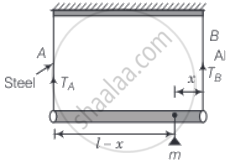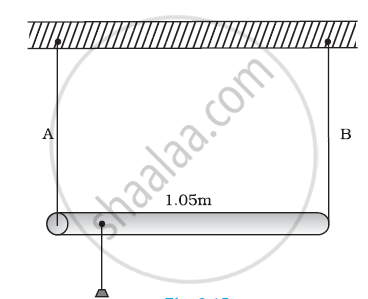Advertisements
Advertisements
Question
A rod of length l and negligible mass is suspended at its two ends by two wires of steel (wire A) and aluminium (wire B) of equal lengths (Figure). The cross-sectional areas of wires A and B are 1.0 mm2 and 2.0 mm2, respectively.
(YAl = 70 × 109 Nm−2 and Ysteel = 200 × 109 Nm–2)

- Mass m should be suspended close to wire A to have equal stresses in both the wires.
- Mass m should be suspended close to B to have equal stresses in both the wires.
- Mass m should be suspended at the middle of the wires to have equal stresses in both the wires.
- Mass m should be suspended close to wire A to have equal strain in both wires.
Solution
b and d
Explanation:
Let the mass is placed at x from the end B.

Let TA and TB be the tensions in wire A and wire B respectively.
For the rotational equilibrium of the system,
∑τ = 0 ......(Total torque = 0)
⇒ `T_Bx = T_A (l - x)` = 0
⇒ `T_B/T_A = (l - x)/x` ......(i)
Stress in wire `A = S_A = T_A/a_A`
Stress in wire `B = S_B = T_B/a_B`
Where aA and aB are cross-sectional areas of wire A and B respectively.
By question aB = 2aA
Now, for equal stress SA = SB
⇒ `T_A/a_A = T_B/a_B`
⇒ `T_B/T_A = a_B/a_A` = 2
⇒ `(l - x)/x` = 2
⇒ `l/x - 1` = 2
⇒ `x = l/3`
⇒ `l - x = l - l/3 = (2l)/3`
Hence, mass m should be placed closer to B.
For equal train, (strain)A = (strain)B
⇒ `(Y_A)/S_A = Y_B/S_B` ......(Where YA and YB are Young moduli)
⇒ `Y_(steel)/(T_A/a_A) = Y_(Al)/(T_B/a_B)`
⇒ `Y_(steel)/Y_(Al) = T_A/T_B xx a_B/a_A = (x/(l - x))((2a_A)/a_A)`
⇒ `(200 xx 10^9)/(70 xx 10^9) = (2x)/(l - x)`
⇒ `20/7 = (2x)/(l - x)`
⇒ `10/7 = x/(l - x)`
⇒ `10l - 10x = 7x`
⇒ `17x = 10l`
⇒ `x = (10l)/17`
`l - x = l - (10l)/17 = (7l)/17`
Hence, mass m should be placed closer to wire A.
APPEARS IN
RELATED QUESTIONS
A steel cable with a radius of 1.5 cm supports a chairlift at a ski area. If the maximum stress is not to exceed 108 N m–2, what is the maximum load the cable can support?
A rod of length 1.05 m having negligible mass is supported at its ends by two wires of steel (wire A) and aluminium (wire B) of equal lengths as shown in Figure. The cross-sectional areas of wires A and B are 1.0 mm2 and 2.0 mm2, respectively. At what point along the rod should a mass m be suspended in order to produce (a) equal stresses and (b) equal strains in both steel and aluminium wires.

A mild steel wire of length 1.0 m and cross-sectional area 0.50 × 10–2 cm2 is stretched, well within its elastic limit, horizontally between two pillars. A mass of 100 g is suspended from the mid-point of the wire. Calculate the depression at the midpoint.
A wire can sustain the weight of 20 kg before breaking. If the wire is cut into two equal parts, each part can sustain a weight of
A load of 10 kg is suspended by a metal wire 3 m long and having a cross-sectional area 4 mm2. Find (a) the stress (b) the strain and (c) the elongation. Young modulus of the metal is 2.0 × 1011 N m−2.
Answer in one sentence.
Define strain.
A rod has a radius of 100 mm and a length of 10 cm. A 100 N force compress along its length. Calculate the longitudinal stress developed in the rod.
Consider two cylindrical rods of identical dimensions, one of rubber and the other of steel. Both the rods are fixed rigidly at one end to the roof. A mass M is attached to each of the free ends at the centre of the rods.
Is stress a vector quantity?
What is an elastomer?
